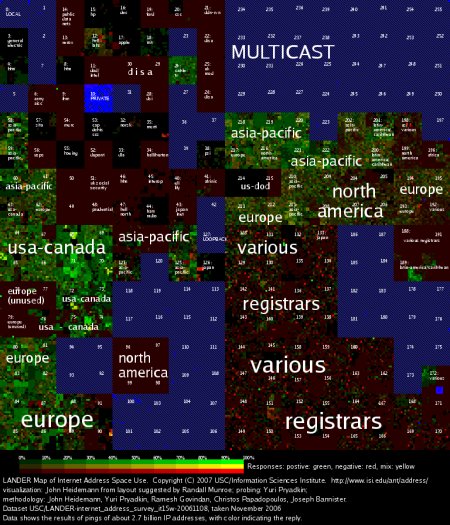Americans compiled Internet Atlas
American researchers pinged all 2 32 IP addresses that could theoretically exist in the IPv4 address space, and conducted a complete census of the World Wide Web — the first such large-scale study since 1982, when the entire Internet consisted of 315 hosts .
A unique experiment was carried out by Yury Pryadkin and John Heidemann from the University of Southern California. The procedure took 62 days.
Of all the pinged addresses, 61% did not give any answer at all. Based on all other information, the researchers compiled a visual atlas of the Internet, which is shown in the screenshot below (clickable). Each of the 256 cells of this atlas reflects the most significant digit of the IP address. The cells are arranged in a fractal order to correspond to the geographical proximity of the nodes to each other. Each cell has 256 pixels from the second digit of the IP address. Green pixels correspond to positive responses to ping, red ones to negative ones. Brightness means the number of positive responses within a given address zone.
')
Perhaps this is the last atlas of the outgoing Internet era. Experts predict that in the IPv4 address space, all addresses will be occupied by 2011, and the transition to IPv6 will be inevitable.

A unique experiment was carried out by Yury Pryadkin and John Heidemann from the University of Southern California. The procedure took 62 days.
Of all the pinged addresses, 61% did not give any answer at all. Based on all other information, the researchers compiled a visual atlas of the Internet, which is shown in the screenshot below (clickable). Each of the 256 cells of this atlas reflects the most significant digit of the IP address. The cells are arranged in a fractal order to correspond to the geographical proximity of the nodes to each other. Each cell has 256 pixels from the second digit of the IP address. Green pixels correspond to positive responses to ping, red ones to negative ones. Brightness means the number of positive responses within a given address zone.
')
Perhaps this is the last atlas of the outgoing Internet era. Experts predict that in the IPv4 address space, all addresses will be occupied by 2011, and the transition to IPv6 will be inevitable.

Source: https://habr.com/ru/post/14945/
All Articles